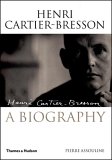
See larger photo
| Henri Cartier-Bresson: A Biography
     
[Click on the appropriate flag to buy the book] | Product Details
Hardcover
280 pages
Thames & Hudson
Published 2005
From Publishers Weekly
Often called the father of photojournalism, Cartier-Bresson tried to give up photography as a profession four times in his life, returning to his first love, painting, repeatedly—but he always kept his Leica in his pocket. The Frenchman captured the emotion and magnitude of some of the 20th century's most significant news stories by simply turning his camera away from the main event and into the crowd. This, too, is Assouline's approach to biography. Drawing on five years of conversations with his subject, Assouline presents not a chronological or critical accounting of events but a portrait, illustrated through descriptions of Cartier-Bresson's photographs (almost none of which are reproduced in the book) and summarized with generalizations of the artist's approach toward art and life: "His taste was classical: he needed that kind of order to counter the vulgarity of the world outside" or "In affairs of the heart, he was a seductive romantic." Energetic and informative passages describe Cartier-Bresson's years as a soldier and his travels to the Ivory Coast, China and India (where he photographed Gandhi just hours before his death). Despite its gaps—such as mere passing references to Cartier-Bresson's two marriages—this smooth hagiography will inspire fans and followers to rediscover its elusive subject's remarkable oeuvre. (Nov. 28)
Copyright © Reed Business Information, a division of Reed Elsevier Inc. All rights reserved.
Book Description
The first full biography ever published—a vivid portrait of this complex, curious, brilliant man.
The twentieth century was the century of the image—and Henri Cartier-Bresson (1908-2004) was the eye of the century. Through the decades, this eye focused on Africa in the 1920s, the tragic fate of the Spanish Republicans, and the victory of the Chinese Communists. It was Cartier-Bresson who fixed in our minds the features of his contemporaries: Giacometti and Sartre as characters from their own works; Mauriac mysteriously levitating; Faulkner, Matisse, Camus, and countless others captured at the decisive moment in portraits for eternity.
An intensely private individual, Cartier-Bresson confided in his close friend Pierre Assouline over a number of years, even opening up his archives to him. Here, for the first time, we read about his youthful devotion to surrealism; his unending passion for drawing; the war and the prison camps; the friends and the women in his life. Assouline provides an acute and perceptive account of the life and philosophy of this icon of our times, and gives us an opportunity to reassess his contribution to twentieth-century photography and reportage. 23 illustrations.
About the Author
Pierre Assouline has written several biographies of major cultural figures, among them books on Georges Simenon and Hergé. |
Manuel Alvarez Bravo, Henri Cartier-Bresson, and Walker Evans.
Documentary and Anti-Graphic Photographs: A Reconstruction of the 1935 Exhibition at the Julien Levy Gallery in New York.
Alvarez Bravo (Photographer); Henri Cartier-Bresson (Photographer); Walker Evans (Photographer); Daniel Giradin (Essay); & Ian Jeffrey (Essay) |  |
|
|
Henri Cartier-Bresson: A Biography
Pierre Assouline (Author) |  |
|
|
|
|
|
|
|
|
The Mind's Eye: Writings on Photography and Photographers
Henri Cartier-Bresson; & Michael L. Sand |  |
|
In Our Time: The World As Seen by Magnum Photographers
William Manchester; Jean Lacouture; Fred Ritchin; Minneapolis Institute of Arts; & Eastman Kodak Company |  |
|
Magnum: Fifty Years at the Front Line of History: The Story of the Legendary Photo Agency
Russell Miller |  |
| | | |

